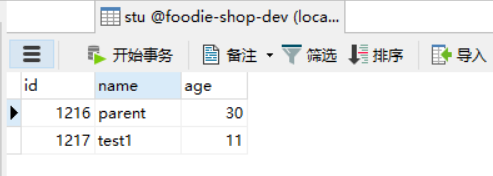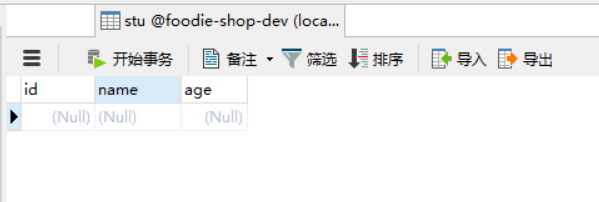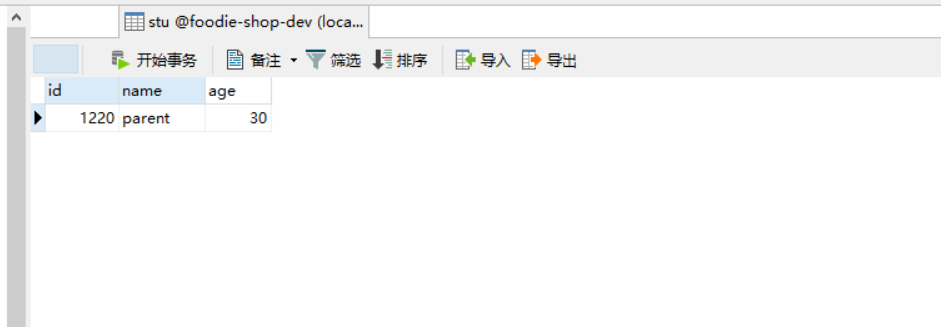Java video tutorial https://www.xin3721.com/eschool/Javaxin3721/ When I went to the interview before, I was asked how to solve a spring nested transaction. When asked, I was speechless. It happened that the current project just used nested transactions. Distributed transactions are also being attempted. So now I have learned something about nested transactions.
https://www.xin3721.com/eschool/Javaxin3721/ When I went to the interview before, I was asked how to solve a spring nested transaction. When asked, I was speechless. It happened that the current project just used nested transactions. Distributed transactions are also being attempted. So now I have learned something about nested transactions.
Concept of transaction isolation level
Transaction propagation - Propagation
REQUIRED: Use the current transaction. If there is no transaction, create a new transaction. The sub method must run in a transaction;
If there is a transaction, join the transaction as a whole.
For example: if the leader has no food, I have money, I will buy it myself and eat it myself; If some leaders eat, they will share it with you.
SUPPORTS: If there is a transaction currently, the transaction is used; If there are currently no transactions, no transactions are used.
For example: the leader has no food, and I have no food; Leaders have food, so do I.
MANDATORY: The propagation property enforces the existence of a transaction. If it does not exist, an exception is thrown
For example: the leader must take care of food. No matter whether there is no food, I don't like it and quit (throw an exception)
REQUIRES_NEW: If there is a current transaction, suspend the transaction and create a new transaction for your own use;
If there is no current transaction, the same is true REQUIRED
For example: leaders have food, but I don't want it. I bought it myself and ate it myself
NOT_SUPPORTED: If there is a transaction, suspend the transaction and run the database operation without the transaction
For example: leaders have food to eat. I'll give you some. I'm too busy. Put it aside and I won't eat
NEVER: Throw an exception if a transaction currently exists
For example: the leader has food for you. I don't want to eat. I love work. I throw exceptions
NESTED: If there is a transaction currently, open the sub transaction (nested transaction), and the nested transaction is committed or rolled back independently;
If there is no current transaction, the same is true REQUIRED.
However, if the primary transaction is committed, it will be committed with the secondary transaction.
If the primary transaction is rolled back, the child transactions are rolled back together. Conversely, if the child transaction is abnormal, the parent transaction can be rolled back or not.
For example: the leader makes a wrong decision, the boss blames, and the leader suffers with his little brother. If the younger brother makes a mistake, the leader can shirk the responsibility.
Attempts in several different situations
There is no transaction isolation level for both parent and child transactions
@Service
public class StuServiceImpl implements StuService {
@Autowired
StuMapper stuMapper;
@Override
//@Transactional
public void saveStuChild() {
saveChildren1();
int i =1/0;
saveChildren2();
}
public void saveChildren1(){
Stu stu = new Stu();
stu.setAge(11);
stu.setName("test1");
stuMapper.insert(stu);
}
public void saveChildren2(){
Stu stu = new Stu();
stu.setAge(22);
stu.setName("test1");
stuMapper.insert(stu);
}
@Override
//@Transactional(propagation = Propagation.REQUIRED)
public void saveStuParent() {
Stu stu = new Stu();
stu.setAge(30);
stu.setName("parent");
stuMapper.insert(stu);
}
}
Parent transactions
@Service
public class TestTransServiceImpl implements TestTransService {
@Autowired
StuService stuService;
@Override
public void saveStudent() {
stuService.saveStuParent();
stuService.saveStuChild();
}
}
@Test
public void TestNoTransactional(){
testTransService.saveStudent();
}
The data before the exception is saved. The data after the exception is not saved

The parent transaction has Required level transactions, and the child transaction has no transactions
@Service
public class TestTransServiceImpl implements TestTransService {
@Autowired
StuService stuService;
@Override
@Transactional(propagation = Propagation.REQUIRED)
public void saveStudent() {
stuService.saveStuParent();
stuService.saveStuChild();
}
}
The stuService code is the same

All transactions are rolled back, and no data is inserted into the database. That is, when the sub transaction has no transaction. Sub methods are also in a transaction. That is, the transaction is passed to the child transaction
The child transaction has Required level transactions, and the parent transaction has no transactions
@Override
@Transactional(propagation = Propagation.REQUIRED)
public void saveStuChild() {
saveChildren1();
int i =1/0;
saveChildren2();
}

You can see that sub transactions only affect sub transactions. The parent transaction is not affected. Methods without a parent transaction are not affected
The child transaction is a support level transaction, and the parent method has transactions or no transactions
- When the parent method has no transactions and the child method has no transactions. Annotate @ Transactional(propagation = Propagation.SUPPORTS)
@Transactional(propagation = Propagation.SUPPORTS)
public void saveStuChild() {
saveChildren1();
int i =1/0;
saveChildren2();
}

j is the same as the initial state without transaction
- The transaction level of the parent method is required. Similarly, as before, data cannot be inserted
The transaction level of the sub method is MANDATORY
Propagation.MANDATORY requires a transaction package, otherwise an exception will be thrown
The transaction level of the sub method is requirements_ NEW
If there is a current transaction, suspend the transaction and create a new transaction for your own use; That is, use your own affairs. If there is no current transaction, the same as REQUIRED. Also use your own transactions
The transaction isolation level of the sub method is NOT_SUPPORTED. That is, transactions are not supported
The parent method without transaction annotation is the same as the case without transaction.
@Transactional(propagation = Propagation.NOT_SUPPORTED)
public void saveStuChild() {
saveChildren1();
int i =1/0;
saveChildren2();
}
The transaction isolation level of the sub method is NEVER,
An exception is thrown if the parent method has a transaction
The transaction isolation level of the sub method is NESTED
If there is a transaction currently, open the sub transaction (nested transaction), and the nested transaction is committed or rolled back independently; If there is no current transaction, the same as REQUIRED. However, if the primary transaction is committed, it will be committed with the secondary transaction. If the primary transaction is rolled back, the child transactions are rolled back together. Conversely, if the child transaction is abnormal, the parent transaction can be rolled back or not.
When the parent method has a transaction and an exception occurs, the child transactions are rolled back together. When an exception occurs in a child transaction. After the server tries.catch, you can choose not to roll back
This mode is used most in daily life. It happened to be used recently.